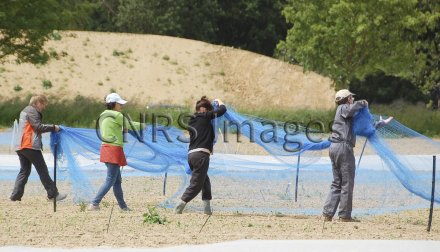Production year
2015

© Rozenn LE GUYADER / GQE - Le Moulon / CNRS Images
20170092_0024
Removing crow protection netting from young maize plants in Le Moulon, in the Paris region. A net is laid over the plot as soon as planting is complete, to prevent crows from digging up the grains of maize. The netting is removed when the plants become autotrophic (i.e. capable of feeding themselves using photosynthesis and nutriments in the soil) at around the five-leaf stage). In suburban areas, a resurgence in versatile birds such as pigeons and crows is prompting farmers to grow less vulnerable species, or to protect their harvests with special-purpose solutions. Scientists at the Quantitative Genetics and Evolution unit in Le Moulon are studying the genetic, epigenetic and molecular control of qualitative and quantitative characteristics and their importance in the adaptation and evolutionary history of plant species. They optimise selection processes based on target characteristics (such as growth, development and adaptation), taking advantage of breakthroughs in genomics and genetic resources, and allowing for changes in environmental conditions and farming methods.
The use of media visible on the CNRS Images Platform can be granted on request. Any reproduction or representation is forbidden without prior authorization from CNRS Images (except for resources under Creative Commons license).
No modification of an image may be made without the prior consent of CNRS Images.
No use of an image for advertising purposes or distribution to a third party may be made without the prior agreement of CNRS Images.
For more information, please consult our general conditions
2015
Our work is guided by the way scientists question the world around them and we translate their research into images to help people to understand the world better and to awaken their curiosity and wonderment.